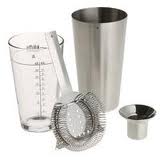So you’ve got your portable bar. Now it’s time to stock it with the equipment you’ll need. We’ve put together a list of essential portable bar equipment you’ll need to run a full service bar from your portable bar.
Cocktail Shaker
There are two primary types of shakers for you to stock your portable bar with: the cobbler shaker and the Boston shaker.
The Cobbler Shaker is the most basic shaker and the one that most novice bartenders use. It’s a metal mixing tin, a built-in strainer, and a small metal cap to cover the strainer while it’s being shaken.
The Boston Shaker is typically considered to be more professional, though more difficult to use for the novice. It consists of a larger metal mixing tin than the cobbler shaker and a boston glass. It requires a bit of practice to get use to since you need to make sure the pint glass is tightly sealed inside the metal mixing glass before shaking. If you are a professional bartender or you’re going to be employing professional bar tenders, this is your best choice.
Strainer
Similar to cocktail shakers, there are two primary types of cocktail strainers: the Hawthorne and the Julep.
Hawthorne Strainer – The Hawthorne strainer is the more well known and widely-used. It’s designed to be used with the mixing tin of a boston shaker and has built in coils to filter out the ice.
Julep Strainer – The Julep strainer is designed to be used for stirred instead of shaken drinks. It originated specifically for the mint julep though it’s used for a variety of stirred drinks now. Unless you have a specific need for it, the Julep strainer probably isn’t necessary.
Cutting Board
Use a cutting board for preparing garnishes for your drinks. Wash it regularly to ensure you have the freshest fruits, herb, and other garnishes possible. Though it shouldn’t be an issue at a portable bar, make sure not to prepare meat on the same cutting board as your garnishes.
Paring Knife
A nice sharp paring knife is a no-joke piece of essential portable bar equipment for preparing your garnishes by cutting, peeling, or twisting them as necessary.
Jigger
A jigger is the best way to control your drink preparation and insure that you’re using proper ratios. This is important both for cost and quality control. While some bartenders claim to feel “constrained” by using a jigger, it’s the easiest way to both control your stock and make sure the client feels they are getting what they paid for.
Liquor Pourers
Liquor Pourers come in two main varieties: measured and free-flow. Measured liquor pourers are designed to pour at a constant rate when the bottle is held at a 45 degree angle. Free-flow liquor pourers are just that, free-flow. More seasoned bar tenders tend to prefer free-flow pourers as they allow for more flexibility and showmanship.
Bar Spoon
A bar spoon can be used for making small, simple measurements, stirring, and layering. It’s usually extra-long to ensure it can reach the bottom of any container.
Corkscrew
If you’re serving wine, make sure you have a corkscrew on hand. The two most popular styles are the winged corkscrew and waiter’s corkscrew. Both work fine and it’s purely personal preference as to which one you should use.
Bottle Opener
Like the corkscrew, a bottle opener is a must-have piece of portable bar equipment. They come in a wide variety of styles. Choose one that’s built to be used industrially and won’t cause frustration to a busy bartender.
Towels or Paper Towels
Towels should be 100% cotton and have sewn edges for durability. Having either paper towels or towels on hand let’s bartenders make good use of downtime to clean bottles and keep the bar tidy.
Cocktail Straws
Don’t forget the straws. These let the imbiber keep their cocktail stirred until the very end.
Cocktail Napkins
Napkins give your drinks a professional appearance and keep the glass from sweating on the drinkers hand or wherever it’s forgotten when music starts bumping…




